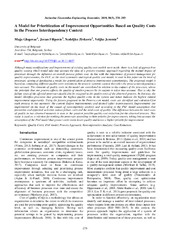Please use this identifier to cite or link to this item:
https://rfos.fon.bg.ac.rs/handle/123456789/1954| Title: | A Model for Prioritization of Improvement Opportunities Based on Quality Costs in the Process Interdependency Context | Authors: | Glogovac, Maja Filipović, Jovan Živković, Nedeljko Jeremić, Veljko |
Keywords: | Quality Costs;Process Approach;PAF model;Nonconformities Analysis;Cost Reduction | Issue Date: | 2019 | Publisher: | Kaunas Univ Technol, Kaunas | Abstract: | Although many modifications and improvements of existing quality cost models were made, there is a lack of approach to quality costing which would take into account the idea of a process-systemic approach regarding the mutual impact of processes through the influence on overall process failure cost. In line with the importance of process management for quality improvements, the PAF, as the most systematic and logical quality cost model, is used in this paper on the level of processes, aiming at developing a model for prioritization of process improvement opportunities. The proposed model is based on comparing different quality costs variants in the process-systemic context that takes the process interdependency into account. The elements of quality costs in the model are considered in relation to the outputs of the processes, where the principle that one process affects the quality of another process by its outputs is taken into account. That is why the failure costs of the affected processes should also be assigned to the quality costs of the observed process. In that way, the model identifies processes that generate the highest quality costs in the system and hence indicate the highest ranked improvement opportunity. Using the factors proposed in the Process cost model, costs are identified and calculated for each process in two moments: the current (before improvements) and desired (after improvements). Improvements are implemented on the basis of the causes of nonconformity analysis and according to the PAF model assumption that preventive and appraisal activities reduce failure costs and the total costs of quality. The difference between the total costs of quality in two observed moments is seen as the greatest possible quality cost reduction for the observed process. This value is used as a criterion for ranking the processes according to their priority for improvements, taking into account the assumption of the PAF model that greater costs mean lower quality and hence a higher priority for improvement. | URI: | https://rfos.fon.bg.ac.rs/handle/123456789/1954 | ISSN: | 1392-2785 |
| Appears in Collections: | Radovi istraživača / Researchers’ publications |
Show full item record
SCOPUSTM
Citations
6
checked on Nov 17, 2025
Page view(s)
10
checked on Dec 14, 2025
Download(s)
6
checked on Dec 14, 2025
Google ScholarTM
Check
Altmetric
This item is licensed under a Creative Commons License


